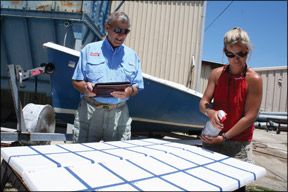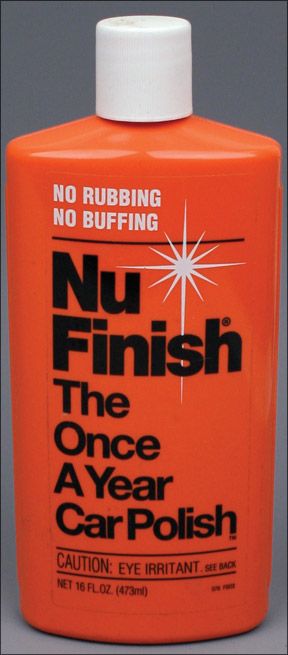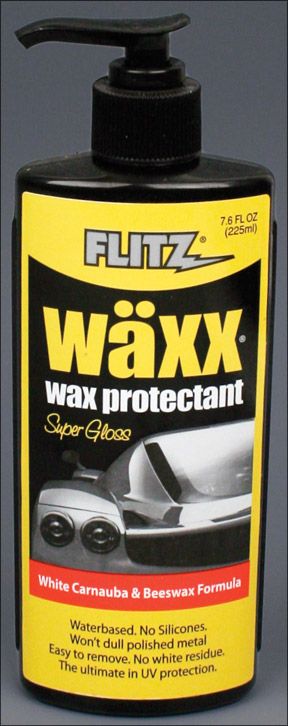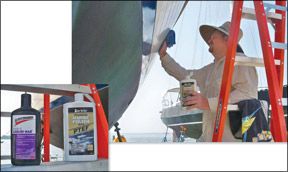Two years ago, we asked readers to suggest bottled waxes and polishes for testing and came up with a list of 27 products, ranging from big name brands to some mom-and-pop concoctions. We applied them to two fiberglass panels and put them out in the Florida sun, wind, and rain. Our last update, after six months of exposure, appeared in the February 2010 issue. This month, we take a last look at these products after they’ve spent 12 months in the weather.

These final results should be put into context. First, many of the products here do not claim to last 12 months. Most instructions call for re-coating after six months, and for a couple, the renewal period is three months. Secondly, although six products were still beading water at 12 months, they did not offer the high-level stain protection, gloss, or water-beading ability PS expects from a wax. Effectively, the winners here were the last survivors, deserving due credit, but in need of re-coating.
It was interesting to note that two finalists at 12 months showed little promise earlier in the testing. The accompanying table shows both the six- month results and the 12-month results, including the Recommended and Cest Choice products for both rating periods. Which results you use to guide your choice will depend on how highly you value things like durability, stain protection, gloss, and eco-friendliness.
WHAT WE TESTED

Most of the products in this comparison are liquid polymers designed specifically for gelcoat surfaces. Some of them claim to be safe for painted surfaces, but we recommend checking with your paint maker before applying them to a painted hull. Abrasives and silicones are not a good idea for painted surfaces.
All of these products come in bottle dispensers; mix thoroughly before applying. Our past tests found that bottled waxes generally do not protect as long as the best paste waxes. Our top recommended paste waxes are Collinite No. 885 Heavy Duty Fleetwax Paste and 3M Ultra Performance Paste Wax (February 2009).
The liquid products in this test are designed to be the final protective layer applied to a new boat or to an old boat that has been thoroughly compounded and polished to a smooth, shiny finish. Although some of these products claim cleaning power, applying them to an oxidized hull will not achieve the best results. For a complete look at the steps to preparing older gelcoat for waxing, see our blog post on hull waxes at www.insidepracticalsailor.com.

If your main goal is simply to protect your hull from further UV damage and make it easier to clean, consider a one-step cleaner-wax (February and November 2007). The products in our 2007 test delivered a decent shine with very little effort and provided up to 12 months of topside protection in Florida. The best product in that test was Star brites One Step Heavy Duty Cleaner Wax.
HOW WE TESTED
For testing liquid waxes, two 3-by-5-foot, white fiberglass hatch covers were washed, dried, and then prepared by machine buffing with 3M Perfect-It rubbing compound and the micro-finishing compound 3M Finesse-It II Restorer to remove scratches. A few products specified using only their own micro-
finishing compounds, which testers used accordingly. Each coating was applied as directed to a taped-off section about 6-by-8 inches and then hand-buffed. Several products recommend multiple coats, but testers applied only one coat of each product for testing.

In blind testing 24 hours after application, evaluators rated each panel for gloss in the sunlight, then sprayed them with a mist of water and rated the relative beading. In a dark room, testers held a multi-bulb LED flashlight over each polished square to rate gloss. The clarity of the reflected LEDs in each square determined the finishs degree of gloss.
After the application and initial ratings, testers mounted the hatch covers face-up in an unobstructed spot on the roof of our workshop in Sarasota, Fla., leaving them to bask in the hot sun, wind, and summer rain. After six months, the panels were again rated for gloss and also were rated for stain resistance by seeing how easy it was to wipe away a dried tea stain, which is similar to the tannin stains that plague waterlines of boats on the Intracoastal Waterway.
For the final rating, at 12 months, testers again looked at stain-repelling ability and gloss, but all of the panels failed to impress in this category. Nevertheless, five waxes clearly stood out for their ability to bead water, indicating that they still afforded some level of protection.
MARINE PRODUCTS
Gelcoat, particularly old gelcoat, is a porous surface and requires a more specialized wax than what youd use on your car. At our six-month checkup, it was no surprise to see marine waxes leading the field. 3M Scotchgard Marine Polish and Star brite Premium with Teflon earned top billing. Collinite Heavy Duty No. 845 Insulator Wax (which is the same formula as its No. 925 Fiberglass Boat Wax) was another winner, and the Island Girl Mirror Guard Super Glaze, an expensive wipe-on polymer, also scored high at six months. West Marines Pure Oceans blend was tapped as an eco-friendly marine option, and the multipurpose Mirage from MP Pros scored as a multi-tasker.

Six months later, only three of the top waxes were primarily marketed as “marine” products. The unanimous winner was Imar Yacht Polish, developed by Imar Marine. Imar markets a dizzying array of yacht detailing products, but its flagship is its cleaner/protectant for Strataglass, the high-grade clear vinyl used in dodgers and cockpit enclosures.
Yacht Polish is a blue-green, scented polish with a petroleum base. It is described as a cleaner and a polish, although we did not test its cleaning ability. It boasts UV protection and no abrasives, and can be applied in the sun or shade. Its gloss and stain resistance were middle of the pack throughout the testing, but at the 12-month mark, its ability to bead water was clearly the best in the field. At $23 a bottle, it costs less than either of the two winners at the six-month mark, 3M Scotchgard Marine Polish and Star brite Premium with Teflon.
The second best marine finish after a year was West Marines “nanotech” Fiberglass

Polish with PTFE (polytetrafuoroethyline, better known by its brand-name Teflon). This product is one of the few that did not use petroleum distillates for cleaning. Instead it a uses a citrus-based cleaner. Its good performance, eco-friendliness, and mid-level pricing earned a recommendation.
The only other marine-focused product still beading water at 12 months was Island Girl Mirror Guard Super Glaze, one of the most expensive products in our test. Island Girl is a quick-dry, wipe-on polymer coating that has no abrasives or cleaning agents. It is a true sealant, and the maker advertises it for a variety of uses, including protecting plastic rubrails, PVC cowlings, chrome, polyurethane paints, even inflatable dinghies.
Island Girl also makes a wide range of specialized protectants. When used on gelcoat, Mirror Hard Super Glaze is supposed to follow Simply Brilliant Superwax, but it can be used alone on new gelcoat.
Island Girl has an impenetrable website with illustrations, directions, and flow charts (yes, flow charts) on how Island Girl products work and how to use them. We strongly suggest you call the maker and describe your project before shelling out $63 for a bottle.
Bottom line: Imars average-to-good performance in the early going is offset by its ease of application and durability over the long haul. For owners of an older boat,

who like the idea of a cleaner-wax and arent fanatical about gloss or stain resistance, this is a good choice. For the eco-friendly sailor, West Marines Pure Oceans Fiberglass Polish with PTFE is an easy first-choice. Island Girl Mirror Glaze clearly has some legs, but price and befuddling application instructions hold it back.
Automotive/Multipurpose Waxes
After our six-month report, we concluded that in general, the car care products “did not hold up as well,” as the marine products. Neither the gloss nor stain protection matched the leaders at that stage. However, at the end of a year, three car products were still beading water, when water was sheeting off most of the marine products. None of these products were as effective at beading water as the Imar Yacht Polish.
The most notable winner in the automotive group was Nu Finish, an inexpensive polymer wax that also fared well at six months. This is an easy-to-use product that can be applied in the sun. It leaves a white residue, so it is not recommended for plastics or painted hulls.
Readers suggested we test two high-end, show-car brands, Zaino Brothers and Glare. While the Glare Professional Polish showed exceptional gloss up to six months, the Zaino Brothers Z3 Show Car Polish was the 12-month champ. Designed for “regular paint finishes” (as opposed to clearcoats), the Z3 has the added bonus of not harming plastics or rubber and being able to be applied in the sun or shade.

Photos by Frank Lanier
A surprise finisher was Flitz Waxx Wax Protectant, a product that is clearly labeled three-month protection in salt water. Touting natural waxes, the Flitz protectant did not stand out upon application or at six months, but it was still beading water after a year. Flitz Waxx Protectant will work on a variety of surfaces, including metal, painted surfaces and clear plastic. It cautions owners not to wash with soap, but to instead use two capfuls of Flitz Waxx in a gallon bucket of warm water.
Bottom line: Of the four automotive products, Nu Finish offers a very economical option. Zainos Z3 or the Flitz will appeal to auto enthusiasts who want one product to polish everything.
Conclusion
Based on our cumulative test results, the average boater looking for an easy-to-apply liquid marine polish that will bead water for 12 months should consider either the Imar Yacht Polish, West Marine Pure Oceans Polish with PTFE, or the Nu Finish. Of the three, the Imar product does a better job dealing with oxidation and stains, while the Pure Oceans holds gloss better. If you want the best gloss and stain protection from a liquid, opt for Star brite Premium polish or 3M Scotchgard and re-apply at the six-month mark. If you want something you can also put on your prized 1953 Willys, the Zaino Show Car Polish or the Flitz Waxx protectant are worth looking into.
Many of these products recommend two or more coats, and this should prolong protection. If you are confident using a power buffer, we also recommend our best paste waxes, either the Collinite 885 or the 3M Marine Paste Wax. Yes, these are harder to apply than the liquid waxes in this test, but weve found that they are worth the effort.








































